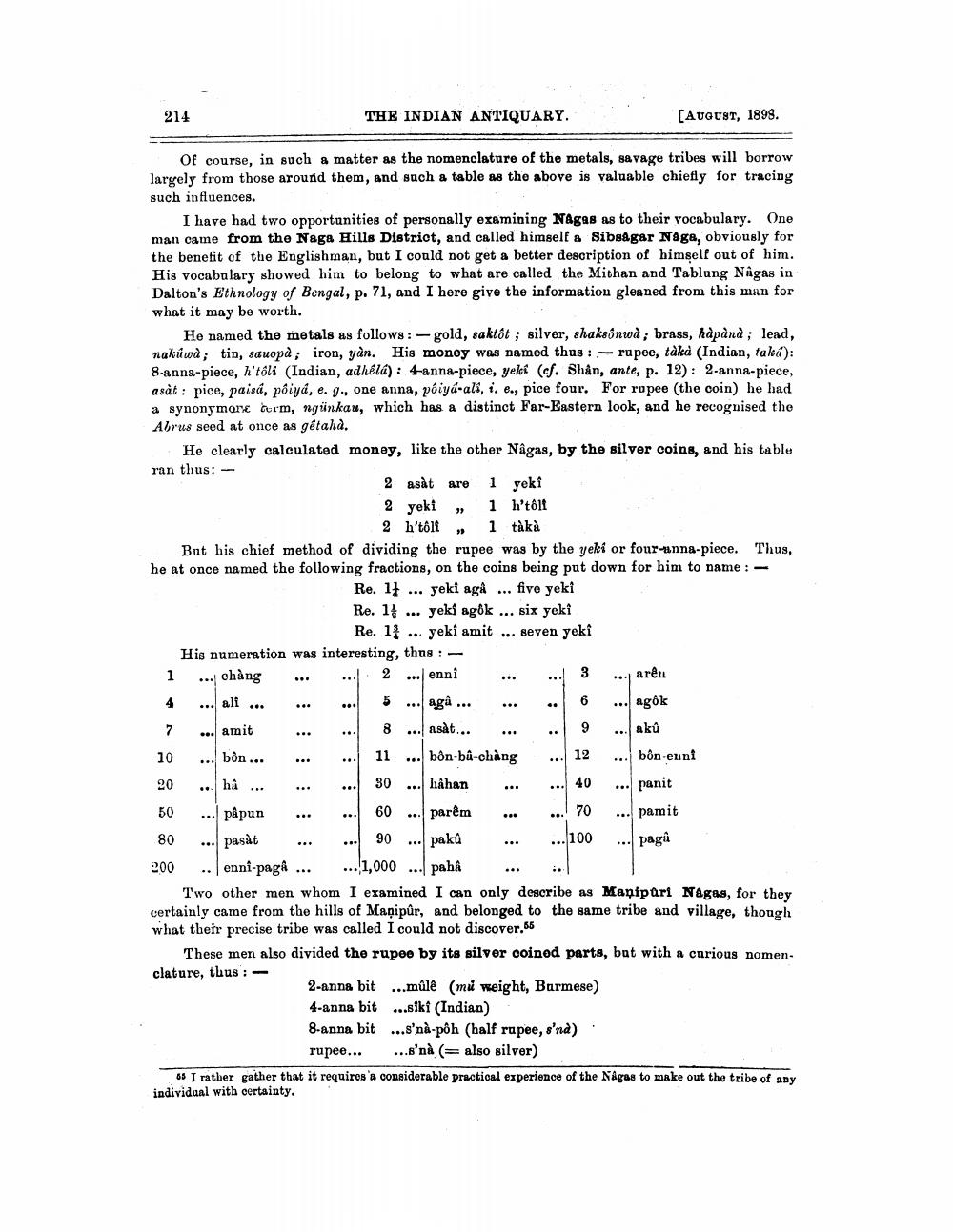________________
214
[AUGUST, 1898.
Of course, in such a matter as the nomenclature of the metals, savage tribes will borrow largely from those around them, and such a table as the above is valuable chiefly for tracing such influences.
I have had two opportunities of personally examining Nagas as to their vocabulary. One man came from the Naga Hills District, and called himself a Sibsagar Naga, obviously for the benefit of the Englishman, but I could not get a better description of himself out of him. His vocabulary showed him to belong to what are called the Mithan and Tablung Nagas in Dalton's Ethnology of Bengal, p. 71, and I here give the information gleaned from this man for what it may be worth.
He named the metals as follows:-gold, saktôt ; silver, shaksonwd; brass, hàpànà; lead, nakuwà; tin, sauopà; iron, yàn. His money was named thus: - rupee, tàkà (Indian, taka): 8-anna-piece, h'tôli (Indian, adhélá): 4-anna-piece, yekt (cf. Shân, ante, p. 12): 2-anna-piece, asat: pice, paisa, pôiyá, e. g., one anna, pôiya-ali, i. e., pice four. For rupee (the coin) he had a synonymore term, ngünkau, which has a distinct Far-Eastern look, and he recognised the Abrus seed at once as gétalà.
He clearly calculated money, like the other Nâgas, by the silver coins, and his table ran thus:
39
But his chief method of dividing the rupee was by the yeki or four-anna-piece. Thus, he at once named the following fractions, on the coins being put down for him to name : - Re. 1... yeki aga... five yeki
Re. 14 yekî agok Re. 1 yeki amit
six yekî seven yekî
...
THE INDIAN ANTIQUARY.
amit
bôn...
...
His numeration was interesting, thus: -
. chàng
2 ... enni
ali
5
8
hâ
... pâpun pasat
...
...
2 asàt are 1 yekî
1 h'tôlf
2 yeki 2 h❜tôli
1 tàkà
1
4
7
10
11
bôn-bi-chàng
20
30
hahan
50
60
80
90
parêm pakû pahâ
200 ..enni-pag...
..1,000
Two other men whom I examined I can only describe as Manipuri Nagas, for they certainly came from the hills of Manipûr, and belonged to the same tribe and village, though what their precise tribe was called I could not discover.55
These men also divided the rupee by its silver coined parts, but with a curious nomenclature, thus:
...
...
...
...
39
agâ.. ...asat...
...
...
...
3
6 9
12
40
70
100
...
2-anna bit...mûlê (mu weight, Burmese)
4-anna bit...siki (Indian)
8-anna bit...s'nà-pôh (half rupee, s'na) rupee... ...s'nà (= also silver)
arên
agok
akû
...
bon-enni
panit
pamit
paga
65 I rather gather that it requires a considerable practical experience of the Nagas to make out the tribe of any individual with certainty.




